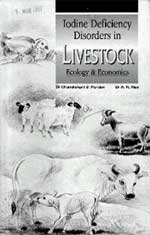Salt of the earth
 iodine is an essential element involved in maintaining relatively constant conditions in the body and in the constitution of thyroxin, a hormone necessary for the regulation of growth and other metabolic functions. Unlike other nutrients, iodine does not occur naturally in foods. Plants absorb iodine from soil and water and serve as a source of iodine for animals that feed on them. As a result, animal and human populations that are totally dependent on food grown on iodine-deficient soil are unable to obtain the necessary amounts of iodine. The necessary levels of iodine are 150 micrograms (mg) per day for human beings and 0.1-0.3 mg/kg dry weight feed for animals.
iodine is an essential element involved in maintaining relatively constant conditions in the body and in the constitution of thyroxin, a hormone necessary for the regulation of growth and other metabolic functions. Unlike other nutrients, iodine does not occur naturally in foods. Plants absorb iodine from soil and water and serve as a source of iodine for animals that feed on them. As a result, animal and human populations that are totally dependent on food grown on iodine-deficient soil are unable to obtain the necessary amounts of iodine. The necessary levels of iodine are 150 micrograms (mg) per day for human beings and 0.1-0.3 mg/kg dry weight feed for animals.
Detailed country-wide surveys have indicated that nearly 29 per cent of the human population is at risk of iodine deficiency, of which 12 per cent has goitre, 26 million suffer from brain damage, and 5.7 million are cretins. Other disabilities are impaired learning abilities and mental retardation.
Animals reared in iodine deficient conditions suffer from poor productivity and reproductive disturbances. India is home to a huge wealth of genetically diverse, environmentally sturdier varieties of livestock with some of the finest draught cattle breeds and top ranking buffalo germplasms. Some 271 million bovines 53 per cent of world buffalo population account for the production of milk, egg, meat and wool , important both for consumption and commerce, which warrants a complete understanding of iodine deficiency disorders ( idd) in terms of its prevalence and the loss it inflicts.
Despite the repercussions on the economy, not much attention has been paid to idd in animals. Even in the case of humans, a major decision in the form of a resolution to eliminate idd came through only in 1990 at Geneva in the 43rd World Health Assembly.
This book records a whole repertoire of idd , both in humans and animals. The authors make it clear that deficiency syndromes occur more due to a deficiency of iodine in soil, water and plants than any other social or economic reasons. The book is divided into seven parts with a serial arrangement of logical arguments for focusing attention on the idd in livestock.
The authors rightly point out that since idd causes a major loss of animal production in commercially important livestock, an effective policy for controlling idd must address the interest of the stakeholders in this problem while simultaneously building an adequate infrastructure, with professional finesse and political will, which can catalyse a sustained effort in the elimination of idd .
As a remedy, the authors prescribe enhanced supplementation of iodine through a fortified regimen, either in the form of salts or as mineral mixtures vehicled through salts, vegetable oil or water feed, all of which will be a low cost venture as the cost of iodisation is low, normally in the range of two-seven us cents per kilogram. The facts and figures presented by the authors show that despite the involved hazards, the use of uniodised salts continues to be in vogue. Therefore, the authors are in favour of a comprehensive ban on the production of uniodised salts as lack of iodine in the diet substantially reduces the yield of eggs, milk, meat, agricultural draught power and dung for cooking fuel and maintaining soil fertility.
This book contains a selection of papers by medical and veterinary scientists, child specialists, nutrition experts, and agriculture and soil scientists and touches upon a variety of idd -related isues. However, a detailed research on how idd incidences have fared over a period of time in the light of increasing production and distribution of supplemented feed would have made it a more precious tool for addressing one of the most common preventable dis eases. Easy comprehensibility with adequate data and simplicity of expression are some positive features of the book. However, the authors have failed to provide enough photographic support showing the manifestations of idd . What is conspicuous by its absence is data based on face to face interviews with the stakeholders in order to obtain an insight into the status of the problem as it exists on the ground and to know how well have the preventive efforts succeeded.
Related Content
- Assessment report by the Space Applications Centre regarding encroachment inside wild ass sanctuary, Little Rann of Kutch, Gujarat, 31/03/2023
- Climate engineering by mimicking natural dust climate control: the iron salt aerosol method
- Hydrogeochemical assessment of groundwater in Kashmir Valley, India
- Sea pollution rate alarming; let’s check it
- Delhi High Court asks for detailed response on the case on banning junk food in schools
- Impact of continental meteorology and atmospheric circulation in the modulation of Aerosol Optical Depth over the Arabian Sea
